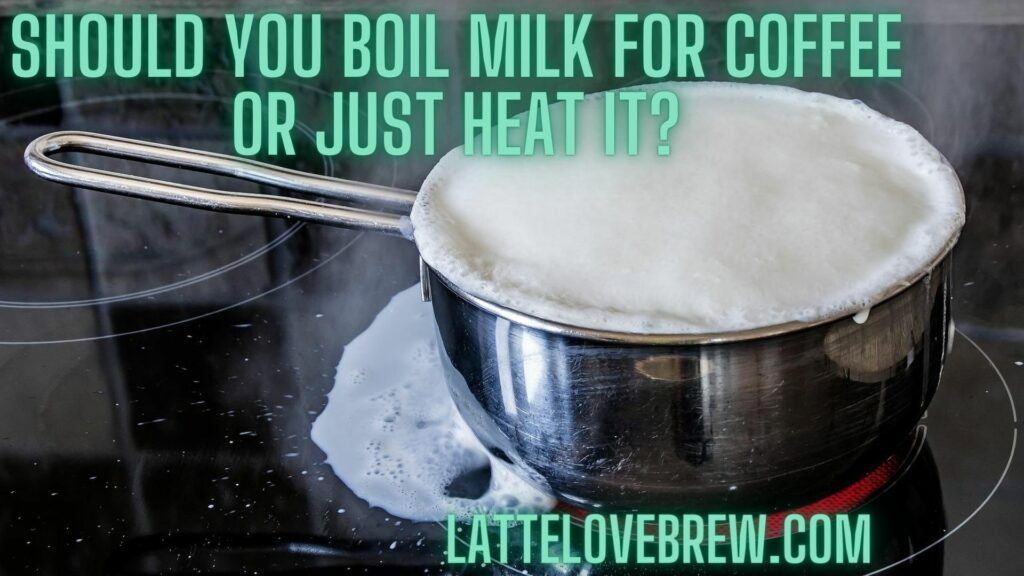Last updated on October 26th, 2023 at 16:34
Getting steamy with steamed milk and coffee. In this article I tackle the whole topic of steamed milk and its use in coffee and the effect it has on coffee.
By the time you have finished reading this article, you will know about steamed milk, how to make it like a professional barista and the pitfalls to avoid.
Keep reading as we dig down and detail the subject of steamed milk and coffee and the importance of making it perfectly every time.
Steamed Milk And Coffee
Table Of Contents
- 1 Steamed Milk And Coffee
- 2 Making Steamed Milk Like A Professional Barista
- 3 Common Mistakes To Watch Out For
- 4 Is Steamed Milk Good In Coffee?
- 5 Steamed Milk Vs Foamed Milk
- 6 Steamed Milk And Espresso Drinks
- 7 Steamed Milk Starbucks
- 8 Frequently Asked Questions About Steamed Milk
- 9 Final Thoughts – Steamed Milk
You can’t be a legitimate coffee lover and not talk about the topic of steamed milk and coffee. It’s like going to Los Angeles and not sleeping with Paris Hilton.
You make the perfect coffee, pull an amazing espresso shot but despite all your coffee making skills you can spoil it if you are not making great steamed milk as most espresso drinks make use of well-made steamed milk.
The most common and popular steamed milk beverages that have at least a single shot of espresso include a latte, flat white, macchiato, mocha, cortado, cappuccino and many more.

Read: Portable milk steamer wand
Making Steamed Milk Like A Professional Barista
The basic technique of steaming milk is basically the same for all coffee drinks. There is only a slight variation in the technique from drink to drink with the largest and most important difference being related to the milk temperature for the different type of milk that you are using, be it full fat, semi-skimmed or any of the wide range of nut based or plant based milks.
Step 1: Fill Your Milk Jug With Milk
A metallic milk pitcher is certainly worth using here as a matter of convenience and quality. Metal conducts heat, is unbreakable, and you can stick a color-changing heat indicating sticker to your jug to monitor easily the temperature of your milk.
Start by using cold milk and pouring until it is at least half full.

Step 2: Get Stretchy
Submerge the tip of your steam wand until it is only about half an inch below the milk surface and start pulling air into your milk.
You should notice a hissing noise. The amount of time that you keep the tip of the steam wand submerged will depend entirely on what coffee drink you are going to make. I like to make the maximum amount of foam as possible.
It is during this point that the fat in milk expands and creates milk foam.
Step 3: Make A Milk Vortex
When you have the right amount of foam and have sufficiently stretched your milk, submerge your milk wand slightly deeper into your milk until you start to see it creating a whirlpool.
Tilt your milk jug slightly and watch the whirlpool of milk as it spins and incorporates the bubbles into your milk. Pay attention to the heat and ensure that you do not go over the ideal milk temperature and that you are not below it either.
Too cold, and you won’t enjoy the rich creamy texture; too hot, and you will destroy the milk proteins and sugars and end up with a slightly burnt taste.

Step 4: Polishing It Up
As soon as your milk reaches the ideal temperature, stop or when your milk jug becomes too hot to touch stop steaming your milk and tap the side of the milk jug a few times in a complete circle. It is best practice to tap your jug 90 degrees apart. Then swirl your milk.
The end result should be milk that looks rich, creamy and shiny like melted ice cream.
The end result should be milk that looks rich, creamy and shiny like melted ice cream.
Step 5: Pour Your Milk
The pouring of your milk happens in two stages. Stage one of your pour is to mix your rich creamy milk with your shot of espresso. The second pour is to smoothly glide and slide the microfoam on top of coffee and create eye-catching latte art.
Latte art is best created free hand and takes practice. At Latte Love Brew we encourage you to make your latte art free hand rather than using a stencil.
Common Mistakes To Watch Out For
As long as you know what to keep an eye for and be aware of avoiding the common mistakes steaming milk will be so easy, no matter what kind of milk you are using.
Overheating Your Milk
This is probably the most common mistake made by baristas both old and new is overheating milk.
When your milk gets too hot, the excess heat breaks down the whey protein, losing you both that rich texture, flavor and the most perfect bubbles.
Have you ever seen a fine layer on boiled milk?
Yes?
That fine skin is broken down milk proteins.

Waiting Too Long After Steaming Your Milk
If you wait too long after you steam your milk, the milk foam will separate from the milk. Keep moving your milk jug and tap the side as soon as you stop steaming it.
Not Creating A Milk Vortex
If you forget to create a milk vortex, you will not get your milk to mix properly, and you will fail to get a creamy texture.
Pulling The Air Too Late
This is probably the second most common error. If you pull the air too late when it is warm, creating high quality foam will be significantly more difficult but not impossible.
Pulling The Air For Too Long
The process of pulling air into your milk is short and sharp and happens in a matter of seconds, typically 5 seconds. The screeching sound of your milk and air is an alarm and an indication that you are pulling the air for too long. It causes larger bubbles to form and spoils your foam.
Is Steamed Milk Good In Coffee?
Yes,
in fact, I’ll go a little further and say that it is excellent in coffee. Steamed milk is essential for making popular espresso drinks like a latte, cappuccino, mocha, flat white, macchiato, cortado and many more milk-based espresso drinks.
Steaming your milk creates a better consistency and improves the quality of your coffee when compared to using cold milk or regular milk. The steaming creates a sweet flavor and velvety-like creamy texture that improves your cup of coffee.
Steamed Milk Vs Foamed Milk
Foamed milk is more voluminous and is longer lasting than steamed milk. It is created by forcing air into the milk by aerating it. Steamed milk is heated in a more delicate matter and is aerated by injecting both air and water vapor into the milk. Steamed milk is more of a microfoam and less fluffy and has a rich silky texture.
Steamed milk is more common as it is used in more coffee drinks than foamed milk.

How To Get Less Foam When Steaming Milk
Obviously, to get an airier forth you keep adding air and vapor and continue to steam your milk with the tip of the milk wand slightly below the milk surface.
For less foam, add less air by using the tip of the wand below the surface of the milk for a shorter period of time and exercise control over the steam pressure coming out of it. Once you have the right amount of foam, dip the tip of the wand deeper into your milk and tilt the jug to create a milk whirlpool and mix the milk foam well with your milk.
If you have excess milk, knock and tip your milk jug two or three times in all cardinal directions and swirl the jug lightly for a few seconds.
Steamed Milk And Espresso Drinks
You can make a number of espresso drinks with steamed milk. Here are just some examples:
- 1. Latte.
- 2. Cortado.
- 3. Mocha.
- 4. Macchiato.
- 5. Pico Latte.
- 6. Flat White.
- 7. Cappuccino.
- 8. Breve.
- 9. Dirty Chai Latte.
- 10. Galao.

Steamed Milk Starbucks
Steamed milk at Starbucks is not at all that different from what you get at a gourmet coffee shop, but notably they use a combination of steamed milk and topped up with very airy frothed milk.
They have a wide range of nut and plant based milks available with soy milk being a popular choice.
Does Starbucks Do Steamed Milk?
Yes, Starbucks has a custom-built fully automatic espresso machine that requires little to no skills from the barista other than pushing a button. The machine heats the steamed milk to a pre-set temperature of 160F, and if you particularly ask for your coffee to be extra hot, it is heated to 180F.
Is Steamed Milk Free At Starbucks?
Yes, when you order your drink like a chia latte for example you can ask for a shot of steamed milk which you will be given free of charge with no extra cost for your shot of steamed milk.
How Does Starbucks Make Steamed Milk?
Starbucks steamed milk is made automatically by their 100% fully automatic coffee machine with little input from their baristas.
For their cold foam they pour non-fat milk into a custom-made high-speed blender that has a special blade for making cold foam that is extra thick, foamy and creamy.
Your requested flavored syrup, be it one or two pumps, is added to the milk prior to it being frothed.
Frequently Asked Questions About Steamed Milk
How Do You Make Steamed Milk?
Steamed milk is super easy to make. Follow the quick step-by-step instructions below:
- 1. Fill your milk jug with as much milk as you need to use.
- 2. Dip the nozzle of your milk steamer into the milk just below the surface of your milk. Approximately half an inch deep is enough.
- 3. Create microfoam, as much as possible.
- 4. Submerge the tip of your nozzle deeper and tilt the milk jug slightly to create a milk vortex. Heat your milk this way until you reach the ideal milk temperature.
- 5. Add your steamed milk to your coffee and enjoy.
Is Steamed Milk Just Hot Milk?
No, steamed milk is a lot more than just simply hot milk. Hot milk is milk that is warm and lacks the aerated frothed milk that has air forced into it to create the silky creamy texture. That texture you cannot get just by heating your milk.
Also, I’ll add that steaming your milk and keeping it with the ideal temperature range will not destroy the whey proteins and maintain a good ratio of milk fats and milk proteins that you need for a quality milk froth and velvet-like texture. A steam wand is a must for making your steamed milk.
What Kind Of Milk Is Steamed Milk?
You can use any kind of milk to make steamed milk. The type of milk that you use does not matter be it coconut milk, almond milk, soy milk, rice milk or plant based milk. What is important is that you adjust the temperature range in which you heat your milk to so that you avoid destroying the milk proteins.
Soy milk has an ideal temperature range of 55C to 65C (130F to 140F) which is more delicate than dairy milk which has a temperature range of 60C to 70C (140F to 160F). Be careful with the hot steam that comes out of your steam wand as if you use it to heat up your for too long it will break down the protein that leads to milk curdling.
Is Steamed Milk Healthy?
Yes, steamed milk is rich in vitamins and minerals and high quality proteins. Steamed milk is a source of vitamin B1, calcium and riboflavin. Milk may help to reduce your blood pressure and osteoporosis. If you are lactose intolerant, avoid steamed milk as it is a source of milk sugar and milk proteins which may cause some problems for you.
Does Steamed Milk Taste Different Than Regular Milk?
Both steamed milk tastes different from regular milk as it has a richer and creamier texture and a lighter body due to jets of air and water vapor adding air bubbles. At the same time that you are heating your milk with the steam wand you are heating the milk sugars and creating richer and sweeter flavor.
Yes, steamed milk not only tastes slightly different due to that creamier and sweeter taste, it has a different texture.
Why Is Steamed Milk So Good?
Steamed milk, and heating milk, is so good as the heat has the effect of increasing the perception of sweetness of milk.
This effect is because the sugars, the longer chain carbohydrates that are present in milk bread down into simple sugars with heat making the sweetness easier to taste.
Is Steamed Milk Healthier?
When you steam milk, you are not necessarily making it any safer to drink. There are some studies that suggest that you may gain additional benefits by boiling milk. There benefits include an increase in both the short chain and medium chain fast which are known to benefit gut health, aid your metabolic health and aid weight loss.
Is Latte Steamed Milk?
Yes, a latte is made with steamed milk. The single or double shot of espresso used to make the base of a latte has twice as much steamed milk as the ratio for a latte is 1:2.
Final Thoughts – Steamed Milk
The topic of steamed milk and coffee is one that is hard to avoid and reading this far you will know much more than 99% of home baristas and exactly how to get that amazing texture and taste to your steamed milk.
Keep practicing as perfect practice makes perfect and be aware of the different temperature ranges for different types of milk as the breakdown of protein happens at different temperatures for soy, coconut and almond milk for example.
Join our fun and friendly coffee community where I and other members discuss brewing tips and techniques to help you brew better coffee. Find us on Facebook/Meta.







